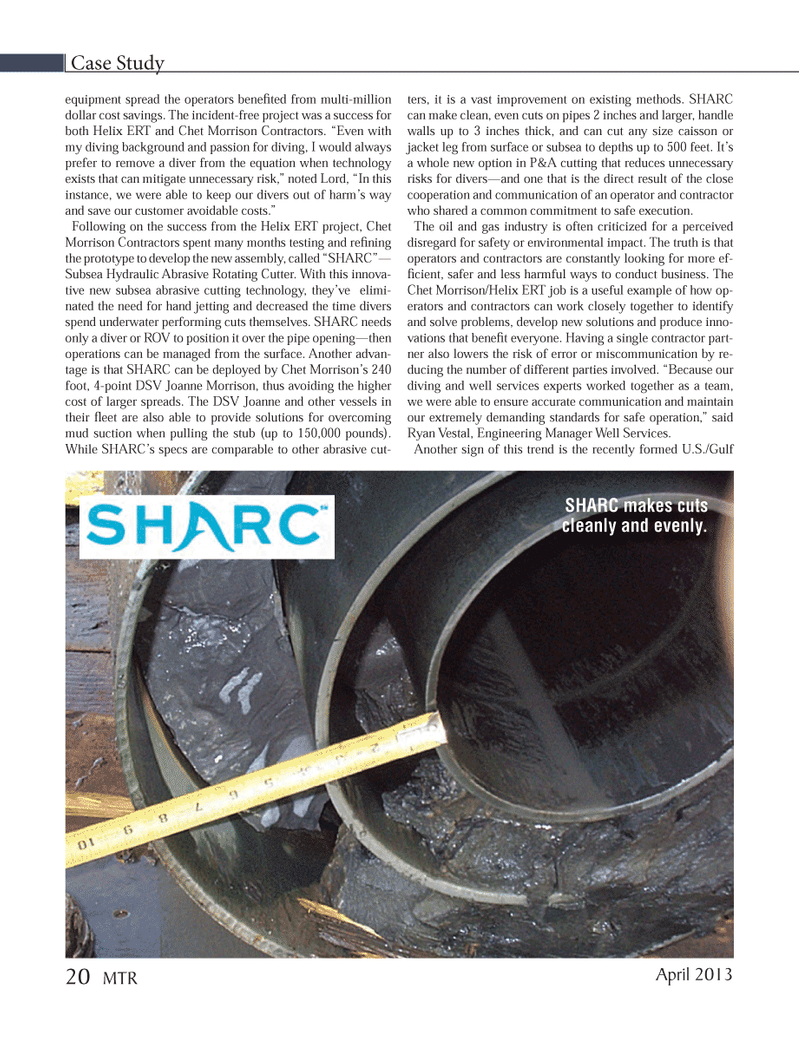
Page 20: of Marine Technology Magazine (April 2013)
Offshore Energy Report
Read this page in Pdf, Flash or Html5 edition of April 2013 Marine Technology Magazine
equipment spread the operators beneÞ ted from multi-million dollar cost savings. The incident-free project was a success for both Helix ERT and Chet Morrison Contractors. ÒEven with my diving background and passion for diving, I would always prefer to remove a diver from the equation when technology exists that can mitigate unnecessary risk,Ó noted Lord, ÒIn this instance, we were able to keep our divers out of harmÕs way and save our customer avoidable costs.Ó Following on the success from the Helix ERT project, Chet Morrison Contractors spent many months testing and reÞ ning the prototype to develop the new assembly, called ÒSHARCÓÑ Subsea Hydraulic Abrasive Rotating Cutter. With this innova- tive new subsea abrasive cutting technology, theyÕve elimi- nated the need for hand jetting and decreased the time divers spend underwater performing cuts themselves. SHARC needs only a diver or ROV to position it over the pipe openingÑthen operations can be managed from the surface. Another advan- tage is that SHARC can be deployed by Chet MorrisonÕs 240 foot, 4-point DSV Joanne Morrison, thus avoiding the higher cost of larger spreads. The DSV Joanne and other vessels in their ß eet are also able to provide solutions for overcoming mud suction when pulling the stub (up to 150,000 pounds). While SHARCÕs specs are comparable to other abrasive cut- ters, it is a vast improvement on existing methods. SHARC can make clean, even cuts on pipes 2 inches and larger, handle walls up to 3 inches thick, and can cut any size caisson or jacket leg from surface or subsea to depths up to 500 feet. ItÕs a whole new option in P&A cutting that reduces unnecessary risks for diversÑand one that is the direct result of the close cooperation and communication of an operator and contractor who shared a common commitment to safe execution. The oil and gas industry is often criticized for a perceived disregard for safety or environmental impact. The truth is that operators and contractors are constantly looking for more ef-Þ cient, safer and less harmful ways to conduct business. The Chet Morrison/Helix ERT job is a useful example of how op- erators and contractors can work closely together to identify and solve problems, develop new solutions and produce inno- vations that beneÞ t everyone. Having a single contractor part- ner also lowers the risk of error or miscommunication by re- ducing the number of different parties involved. ÒBecause our diving and well services experts worked together as a team, we were able to ensure accurate communication and maintain our extremely demanding standards for safe operation,Ó said Ryan Vestal, Engineering Manager Well Services. Another sign of this trend is the recently formed U.S./Gulf Case Study SHARC makes cuts cleanly and evenly. 20 MTRApril 2013MTR #3 (18-33).indd 20MTR #3 (18-33).indd 204/3/2013 10:57:19 AM4/3/2013 10:57:19 AM

 19
19

 21
21
